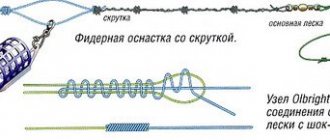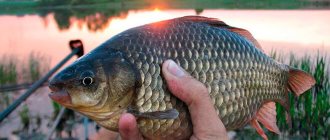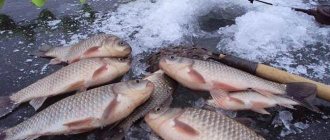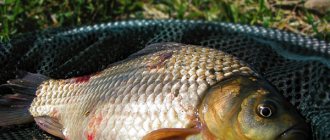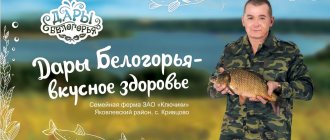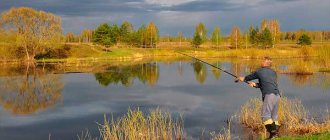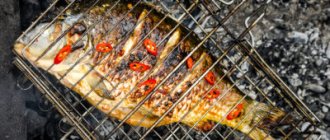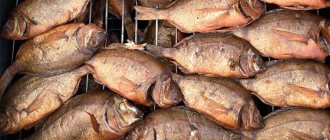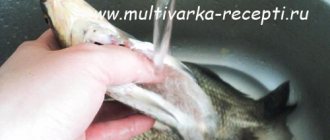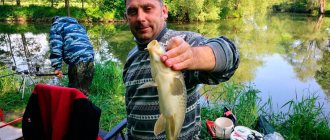Very often, people living in large cities have a desire to go out and relax in nature. And there is nothing better than going fishing. And, as you know, one of the most popular fish is crucian carp. Where in the near Moscow region can you not only relax comfortably, but also catch a couple of kilograms of this delicious fish?
Let's take a look at the reservoirs in the Moscow region where you can catch crucian carp quite successfully. The article presents lists of successful fishing spots for catching crucian carp in the following reservoirs:
- Paid ponds
- Free ponds
- Rivers and lakes
Before we start reviewing the reservoirs, let's go on a fishing video trip and see how ardent fishing fans catch crucian carp on a plug float in the Moscow region.
So, let's get started with a review of catch-producing ponds in the Moscow region.
Crucian carp as it is
More precisely, both crucian carp. After all, there are two types of them - gold and silver. Mixing them together is at least unethical from a fishing point of view, because between these fish, which are very similar to each other, there are quite noticeable differences, including those related to living conditions.
Yes, there are places where they live side by side, but there are also many lakes where you will never find a goldfish, again - you will find them in ponds and rivers where catching a goldfish is a sensation. This is due to the fact that golden crucian carp is less demanding of dissolved oxygen than silver crucian carp, but does not tolerate flowing water, and silver crucian carp, in turn, is more demanding of the content of life-giving gas, but at the same time, it completely tolerates the leisurely flow of plains. rec.
On top of everything else, silver crucian carp has one important ability: its eggs can be fertilized by the milk of other carp fish. Biologists call this gynogenesis (you can find out more about it in the article on the spawning of crucian carp). It's funny, but during the process of population growth, gynogenesis works as a kind of "anti-competitive" tool.
There are known cases of gold crucian carp completely displacing golden carp from their usual habitats, as well as sudden outbreaks of the former’s numbers, as a result of which it occupied a dominant position in the reservoir.
It turns out that the goldfish has its own “card up its sleeve” for the goldfish. Do both fish have any trait that gives them an advantage over other representatives of the ichthyofauna? Of course there is, and this is their main trump card.
The advantage of gold and silver crucian carp over other fish
As mentioned above, both crucian carp are very undemanding to oxygen. However, like some tropical fish, they cannot breathe atmospheric air.
If the oxygen concentration in the water falls below the survival threshold, the crucian carp burrow into the silt, and quite deeply (up to 70 cm, or even more). There they fall into a special state comparable to suspended animation.
How long can crucian carp stay like this is an interesting question. It is known for certain that it tolerates complete drying out of a reservoir within a few weeks with a bang, as well as freezing to the bottom in winter and death at the same time. There is even information that crucian carp can supposedly remain in the silt for years (I remember an old story about how they dug a pit in the place of a long-drained swamp, and dug up several crucian carp, which came to life when placed in clean water).
Most other fish that live in our waters do not have the ability to bury themselves in mud. Therefore, in reservoirs that become very shallow, or completely dry out in the summer, as well as frozen in the winter or frozen to the bottom, these fish simply do not survive. There, only rotan can seriously compete with crucian carp - which is even more unpretentious and tenacious. And tench and lake minnow, which are usually adjacent to crucian carp in such reservoirs, occupy a slightly different ecological niche and do not particularly compete with it.
"Vulnerabilities" of crucian carp
However, in much less extreme reservoirs - with normal oxygen conditions - other fish survive calmly, and this is where the crucian carp’s weak points begin to “pop up” one after another. Immediately he has serious food competitors and worst enemies. Both of them are capable of quickly “bringing the crucian cart under the monastery”, nullifying its existence in a particular reservoir.
The very first weak point is slowness. Crucian carp more often than other fish becomes prey for pike, which may even begin to catch it selectively. Of course, it’s such a well-fed trophy that you don’t really need to chase after it.
The second vulnerability is the late timing of spawning - in crucian carp it usually happens after the spawning of other fish, therefore - crucian caviar becomes a universal delicacy. But the crucian carp has nothing to answer - when its neighbors spawn in the spring - it only barely emerges from hibernation, and at this time it feeds rather sluggishly.
The third vulnerability is dependence on a specific soil. If there is no decent layer of soft silt in the reservoir, where the crucian carp could burrow and overwinter, it simply overwinters at the bottom. Lethargic and even slower, it becomes very easy prey for predators. True, in some reservoirs conditions allow it to remain vigorous even in winter, but these are in the minority.
The only thing that can save crucian carp from the three above-mentioned misfortunes is an excellent food supply, that is, the same decent layer of silt at the bottom and well-developed aquatic vegetation. The fry in such “lands” will grow quickly; predators will not have time to devour them all before the fish can carry out their first spawning. But here the main food competitors immediately appear - bream, carp, roach, ruff. These fish, of course, are not as terrible for crucian carp as predators, but they also significantly affect the density of its population.
Reservoirs where crucian carp live
It's time to tell about all the possible reservoirs in which crucian carp live. I’ll start with those in which there are all the necessary conditions for this fish - where it dominates and thrives.
Small enclosed lakes
Photo 3. River oxbows are typical places where crucian carp are usually caught. Author of the photo: Irina Starkova.
For the most part, these are river oxbows formed by changes in the bed of medium-sized or more or less “large” small rivers. It can also be flooded quarries, pits, silos, mines, small lakes in the middle of swamps. Simply put, all those small bodies of water that are fed only by precipitation and groundwater. The main conditions are the depth and thickness of the silt. The sum of their values should slightly exceed the thickness of winter freezing, otherwise the crucian carp is in danger of dying.
With all that, the reservoir must be of a certain age, that is, with a formed ecosystem. External signs are developed semi-aquatic and aquatic vegetation (cattail, reeds, pondweed, duckweed).
In such closed lakes, the oxygen regime is the most extreme, therefore only golden crucian carp can be found in them, usually in splendid isolation, because other species of fish simply will not survive here. The crucian carp is at ease here - without predators or food competitors, so it quickly overpopulates the reservoir and degenerates into a slow-growing form. As a result, the lake is simply teeming with crucian carp, but most of them are small - the length of a finger.
However, as this very “extreme” decreases, species such as tench and lake minnow may well appear. And sometimes this happens - rotan falls into the lake. That's it - you can give up on crucian carp and other fish. Quite quickly, rotan will multiply and completely destroy them, after which it will be the rightful owner of the pond for many years - until it silts up and becomes completely overgrown.
Small bodies of water with low water flow
Photo 4. A small village pond built on a small river. There is not only one crucian carp in it, but it occupies a dominant position.
These are still the same oxbow lakes, but with tributaries in the form of streams, or connected to the main channel by channels. These can also be village ponds (staves), built on streams and very small rivers. The oxygen regime in them is already noticeably better than in previous reservoirs: in addition to crucian carp (both gold and silver), ruff, roach, carp and even perch and pike can be found here. Nevertheless, sometimes death occurs in such reservoirs.
Therefore, crucian carp have food competitors and enemies, but periodically their populations are subject to “thinning” by unfavorable factors. Therefore, other fish cannot radically influence the number of crucian carp, therefore it is found here in sufficient quantities, moreover, a considerable part of the individuals reach quite good sizes.
Such reservoirs can be considered ideal from a fisherman’s point of view. Fishing for crucian carp is the most interesting here.
Wetland lakes
Photo 5. In hard-to-reach swampy lakes, crucian carp feels at ease.
These can be medium-sized and even large lakes, located among extensive swamps, or simply with heavily swampy shores, overgrown with reeds and cattails, or even with developed rafting. The main distinguishing feature of such reservoirs is dark peat water. The oxygen regime in them is relatively good (although the likelihood of death still remains), therefore, in addition to crucian carp, roach, perch and pike can be found here.
Crucian carp here also reaches sufficient numbers and decent sizes, including due to a good food supply.
Such lakes are often difficult to access. To get to open water, you have to travel some distance through the swamp, sometimes not without the danger of falling through. But, no matter how difficult the path, the fisherman will be generously rewarded. After all, this is where the largest and most well-fed crucian carp are found.
Rivers
Photo 6. If there are places on the river with a slow current and a muddy bottom, crucian carp may well live there.
If rivers have areas with a slow flow, a muddy bottom, as well as quiet branches and bays, overgrown with aquatic vegetation and also silted, then there is a very high chance of catching silver crucian carp in them. But it is worth considering one small nuance: in rivers, this fish can retain its “lake” appearance, or it can form a special, “river” ecological form, which is noticeably different - its body is more propulsive, better adapted to overcome the current. Such “river crucian carp” can be found on pebble shallows, or even in rapids areas with a decent current, where the fish stands in a lull after stormy water - this, for example, is typical for some rivers of the Crimea.
Other bodies of water with normal oxygen conditions
Where the probability of death tends to zero, the crucian carp has to fully reckon with the rest of the inhabitants of the reservoir, and therefore it no longer reaches large numbers.
These are any flowing ponds and reservoirs with a good supply of fresh water, medium and large lakes - also with tributaries. At best, crucian carp will be found here infrequently, but most likely it will be found in single specimens (someone launched at some point by someone), or even completely absent.
Alas, nothing can be done about it. But such reservoirs can please the fisherman with good chebaks, bream and other fish.
Making a pond with crucian carp
The pond should not be too large, but large enough for successful fish breeding. In the designated location, using an excavator, dig a quarry 6 m long and 4 m wide. The depth can be up to 1.5 m. You can take other sizes, but the combination of these is optimal.
It is advisable if the walls are flat and the pond has a shallow depth of up to 0.5 m. Here the water will be warmer and more comfortable for the fry. It is better if the pond is round in shape with low banks. They can be lined with large stones to give the pond an aesthetic appearance. In a pond of this size, several dozen small crucian carp can live.
You need to release crucian carp into the reservoir in early spring. But this must be done carefully. Gradually add pond water to the fish transport container, changing the temperature by 1 to 2 degrees over an hour. Otherwise, due to a sharp change in water temperature, the fish may experience temperature shock and die within 24 hours.
Where and how to look for crucian carp?
But now, perhaps, it’s time to talk about ways to detect crucian carp reservoirs.
The first way to determine where crucian carp is caught is to resort to word of mouth. This is a study of fishing forums, especially small-town ones, a survey of fishermen in villages (if reconnaissance is carried out in force). But we, for example, have recently become more alert to look for crucian ponds and lakes using maps and satellite images, because it does not always happen that a body of water - for which there is a question about the presence of crucian carp - has appeared on the Internet. But there are a number of external signs that are clearly visible from a satellite - from them you can get some idea about the nature of the reservoir, and accordingly, you can roughly estimate how likely it is to be a crucian carp.
The easiest places in this regard are oxbow lakes. They are all, as a rule, inhabited by crucian carp, and quite densely (even if it does not live there alone). Perhaps in the largest oxbow lakes, formed by grandiose rivers, this fish can sometimes represent a minority.
With ponds the situation is more complicated, because their characteristics vary greatly, and not all of them are easily identified from photographs. However, there are still a number of signs pointing to crucian carp.
First of all, you should pay attention to the size of the main influx. The smaller its spillway, the slower the water renewal, which means the worse the oxygen regime in winter and in the summer heat - which is only a plus for crucian carp, unlike its competitors. A pond can be “downstream,” that is, it begins immediately from the dam of another pond built upstream. Observations have shown that in such “lower” reservoirs the chance of catching crucian carp is noticeably higher than in the “upper” ones. Apparently - again due to the fact that the oxygen regime is a little worse.
Another very good sign is aquatic vegetation. On satellite images, it appears in two ways: as silvery-light spots on the surface of a reservoir (somewhat similar to ripples, but blurry) and as green spots-islands (usually round in shape). If all this is present only in the upper reaches, and the rest of the pond is clean (or slightly overgrown along the banks), then most likely the reservoir is ordinary - with a “standard” set of fish. But if patches of vegetation are observed in the middle of the pond, or even better - in the water area near the dam, then the probability that crucian carp is caught here tends to almost one hundred percent.
For crucian carp with a float and donka
Photo: Alexander Tokarev.
Crucian carp begin to spawn closer to four to five years of their life.
Usually their spawning coincides with the flowering period of viburnum, in May-early June.
And they start pecking quite early, already in April-May, as long as the water temperature is at least eight degrees.
It is clear that the very first catching places will be shallow waters warmed by the sun, where the depth can be only about twenty centimeters.
Especially if in such places there are natural shelters: snags, tufts of sedge, bushes, last year’s grass.
Fishermen use this and in places where there are no such shelters, they make them themselves, throwing spruce branches, twigs and willow bushes.
After spawning, crucian carp does not immediately begin to fatten. If the spawning was in good weather, and the fish immediately and unanimously spawned, then there is a temporary lull, a rest for the crucian carp, and for the crucian fisherman - a damned time of no bite... But this does not last long, but then a good bite immediately begins.
Despite the activity of the fish, it is better to catch crucian carp in important places. And here there are some peculiarities. Since these lazy fish stay in places completely overgrown with hornwort, pondweed, and reeds, hooking the fish should be done the hard way, but the most effective way.
Read the material “When choosing a fishing location, you need to focus on plants”
If there are natural openings among this vegetation, then this is where the feeding point should be located, in the language of feeder lovers.
Well, if there are no such places, you can use the method that is used for catching cautious large tench: mow the plot with a special or regular scythe, pour river sand into it and feed the fish, as on a table, on which the bait is visible, and the attachment or bait is on the hook .
Of course, all this trouble is needed where crucian carp of decent size lives. Dwarf crucian carp, which do not grow in small ponds, peck even without bait, much less bait.
Like most fish, crucian carp also bite best at dawn. Especially large ones, which in some ponds and lakes are also taken at night, when crucian carp up to two kilos are caught... But night fishing requires other gear and devices.
Usually the floats are either illuminated with a good flashlight, or they are caught using glowing floats. But it is more convenient for night donk fishing with a rubber shock absorber. It does not require casting, like a float rod, which is not easy to cast in the dark and by the light of a flashlight.
Usually, during daylight hours, a load of “rubber band” is brought in by boat. At the same time, it doesn’t hurt to remember all the grassy areas of the reservoir and the spits next to them, where you can put hooks with bait on the bottom. You can also mark catchy spots using a navigator.
| Photo: Alexander Tokarev. |
When the load has been brought in to the critical tension of the ten-meter shock absorber, which can be seen from the whitened rubber, the main fishing line is secured with a blind loop on the shore, putting the loop on a peg. And the undergrowth with leashes and hooks is laid out on a clean bank, baited with worms or maggots, and black bread, barley, semolina or mash are planted.
There is no longer a secret that crucian carp loves garlic. And I simply plant pearl barley grains or dung worms with my hands rubbed with garlic. Although, of course, there are various garlic flavors.
Read the material “The influence of smell on biting”
After this, the line is carefully released into the water, carried away by the tension of the shock absorber rubber. The catch point is determined experimentally. And there you should lower the hooks to the bottom.
Unlike the “rubber band” for catching sabrefish, a sinker is placed on the undergrowth of a crucian carp bottom with a rubber shock absorber. The bite is determined either by the ringing of a bell, or by a tug, when the fishing line is in the hand, it is slightly pulled up and released into the water.
During active biting, the line is simply held on the finger, to which all the touches of the fish on the bait are noticeably transmitted.
It should be noted that often the most successful spring bait on some reservoirs is caddisfly, which can be found in shallow coastal waters, as well as in streams.
Traces of the larvae are visible on the silt in the form of oblong hollows, and the caddis flies themselves sit in tube-like houses that resemble twigs at the bottom.
The bite of crucian carp, even though it is lazy, is often quite energetic, especially if the fish is large. But sometimes his stretches are barely noticeable. It’s like with a float, when it falls flat, and then rises and goes obliquely into the depths. All these subtleties of biting can be quickly learned through experience.
There are no particular differences in the equipment of a float rod for catching crucian carp or other fish. This can be a regular fishing rod with guides or a fly fishing rod, but the equipment should be a little thinner and smaller.
There are many floats for catching crucian carp of the “needle” type, but for some reason the classic goose feather, known since the time of Sergei Timofeevich Aksakov, is more convenient and familiar to me.
Read the material “They want to equate bows with hunting weapons”
If you use vegetable baits, then carp hooks with a short shank are most convenient. To attach worms, it is better to use hooks with a regular shank.
| Photo: Alexander Tokarev. |
The rod is mostly long, since you often have to cast the tackle behind a strip of coastal grass or in shallow water near the shore into a hole that is blue in the distance.
But on some ponds it is impossible to use a regular float rod. Here you will need running equipment. It is now called Bolognese in its modern version.
The Bolognese fishing rod requires a spinning reel, with which long casts are possible. Floats with a fishing line attached to the body of the float through a special tube are also used. This prevents the fastening from being pulled out of the float body during strong hooks.
A rod about 6 meters long is preferable, since the Bolognese rig uses sliding floats, but more reliable, sensitive and convenient floats with a blind mount. And they are used if the depth at the fishing spot does not exceed the length of the rod.
Quite often, a pickerel can give odds to any other gear. This sensitive and convenient bottom with a thin, replaceable tip has replaced many tackles, and quite rightly, since it is very practical and fast when catching small fish in calm waters, although, of course, large fish are also caught with a picker, the landing of which is made easier by a spinning reel.
Read the material “Bear hunting: what it should be like”
I noticed that the process of fishing with a picker is often faster and more successful than with a running float rig.
In addition, the picker can be equipped not with a weight and fed with bait not from a slingshot or by casting it by hand into the fishing spot, but by placing a light spiral feeder or a flat feeder that does not fall into the soft silt of a pond, river bay or lake. Then the hooks with bait will always be in the feeding zone.
Alexander Tokarev July 1, 2021 at 11:44 am
We found where crucian carp is caught - and what next?
However, finding crucian carp is not always enough to start catching it consistently. In many bodies of water, this fish is known for its pickiness and capriciousness - this is nothing more than a consequence of a special behavior model developed in extreme conditions in the presence of competition from other fish.
Where crucian carp coexists with other species, it begins to behave as follows:
- In order to avoid being eaten by predators, it moves and feeds according to a strict schedule - during the hours when they are resting.
- In parallel with this, all his migrations take place to the safest places - the so-called. "Crucian paths"
- In order to reduce food competition, crucian carp selectively begins to feed on one food, the easiest and safest to obtain. From the shore it looks like a complete reluctance to bite on the usual baits.
- In order to generally protect itself from any unfavorable factors, the crucian carp becomes paranoidly suspicious and becomes wary for any little reason.
You can read more about why crucian carp do not bite in some reservoirs, and what to do in this case, here.
